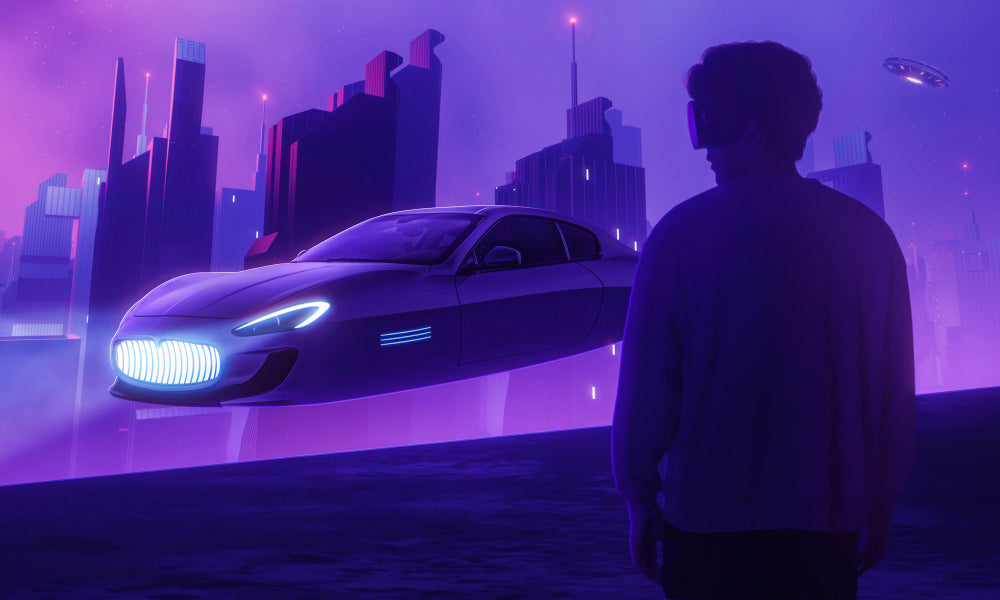Revolutionizing the Test Drive Experience: Virtual Reality and 3D Modeling

Introduction
In the ever-evolving world of automobile marketing, staying ahead of the competition requires embracing innovative technologies that can transform the customer experience. Two such technologies, virtual reality (VR) and 3D modeling, are revolutionizing the test drive experience, providing customers with immersive and realistic encounters with virtual cars.
In this blog, we will explore the importance of test drives in automobile marketing and how emerging technologies like VR and 3D modeling are shaping the automotive industry.
I. Importance of Test Drives in Automobile Marketing
Test drives have long been a crucial element in the automobile marketing process. They allow potential buyers to experience the look, feel, and performance of a car before making a purchase decision. Test drives provide a hands-on experience that helps customers assess the comfort, handling, and overall suitability of a vehicle. Additionally, test drives create an emotional connection between the customer and the car, making it a pivotal factor in the decision-making process.
While traditional test drives have their merits, they are not without limitations. Virtual test drives, powered by VR technology, overcome these limitations and offer a range of advantages for both customers and automotive brands.
Virtual test drives address the limitations of traditional test drives by offering an immersive and convenient alternative. Through VR technology, potential buyers can experience the thrill of a test drive without leaving their homes. They can explore a wide range of car models, configure custom options, and even simulate various driving conditions - all in a virtual environment. This flexibility and accessibility enhance the customer experience, enabling them to make more informed decisions.
Virtual reality takes the virtual test drive experience to a whole new level. By wearing a VR headset, customers can enter a digital world that replicates the look and feel of a real car. They can interact with the car's interior, experiment with different features, and even take simulated drives through virtual landscapes. This immersive experience enhances customer engagement and allows them to visualize themselves in the driver's seat of their dream car.
II. Exploring 3D Modeling in Automobile Marketing
In addition to virtual test drives, 3D modeling plays a significant role in creating realistic virtual cars and enhancing the overall automobile marketing experience.
-
Overview of 3D Modeling Technology
3D modeling involves the creation of virtual representations of physical objects using specialized software. In the context of automobile marketing, 3D modeling enables manufacturers to create highly detailed and accurate virtual cars. Every aspect, from the exterior design to the interior features, can be replicated with precision, offering customers a realistic and visually appealing experience.
-
Role of 3D Modeling in Creating Realistic Virtual Cars
The main objective of 3D modeling in automobile marketing is to create virtual cars that closely resemble their physical counterparts. Using advanced rendering techniques, manufacturers can capture intricate details such as the contours of the body, the texture of the upholstery, and the fine craftsmanship of the interior elements. This attention to detail elevates the realism of virtual cars, making customers feel as though they are interacting with the actual vehicle.
-
Showcasing Concept Designs and Customizations
3D modeling also enables the presentation of concept designs and customizations to potential buyers. Automotive brands can showcase futuristic prototypes, concept cars, and various customization options, allowing customers to visualize their dream cars. This level of personalization enhances customer engagement and empowers them to make choices that align with their preferences and needs.
III. Virtual Reality and 3D Modeling: The Perfect Pair
The integration of virtual reality and 3D modeling creates a synergistic effect, offering immersive and personalized experiences that elevate automobile marketing to new heights.
-
Integration of VR and 3D Modeling for Immersive Experiences
By combining VR and 3D modeling technologies, automotive brands can create immersive experiences that go beyond traditional marketing approaches. Customers can step into a virtual showroom, interact with virtual cars, and take virtual test drives, all within a visually stunning and realistic environment. This integration enables customers to engage with the vehicles on a deeper level, fostering a stronger emotional connection and driving purchase intent.
-
Benefits of Using VR and 3D Modeling in Marketing Automobiles
The benefits of using VR and 3D modeling in automobile marketing are manifold. Firstly, they provide an opportunity for automotive brands to differentiate themselves from competitors by offering unique and memorable experiences. Secondly, virtual reality and 3D modeling allow brands to reach a broader audience, transcending geographical boundaries and making test drives accessible to customers around the world. Finally, these technologies enable automotive brands to showcase their innovation and technological prowess, reinforcing their position as leaders in the industry.
-
Creating Interactive and Personalized Virtual Showrooms
VR and 3D modeling also empower automotive brands to create interactive and personalized virtual showrooms. Customers can explore the exterior and interior features of a car, configure custom options, and visualize the vehicle in different settings. This level of interactivity and personalization creates a sense of ownership and involvement, strengthening the bond between the customer and the brand.

IV. Advantages of Virtual Test Drives
Virtual test drives offer numerous advantages that significantly enhance the car buying experience for customers.
-
Overcoming Geographical Limitations
Virtual test drives eliminate the constraints of distance and travel, allowing customers to experience test drives from the comfort of their own homes. This accessibility opens up opportunities for automotive brands to reach a wider audience and engage with potential buyers who may not have easy access to physical dealerships.
-
Allowing Customers to Explore a Wide Range of Models
Virtual test drives provide customers with the freedom to explore and compare a vast selection of car models. They can test drive multiple vehicles, experiment with different configurations, and make informed decisions based on their preferences and needs. This comprehensive exploration expands customers' options and ensures that they find the perfect vehicle to suit their lifestyle.
-
Providing a Safe and Controlled Test Drive Environment
Safety is a significant concern when it comes to test drives. Virtual test drives provide a controlled environment where customers can experience the thrill of driving without any risks associated with real-world scenarios. They can familiarize themselves with the vehicle's features, test its performance, and evaluate its suitability for their driving style, all while maintaining a safe and controlled setting.
V. Creating Realistic Virtual Cars
The realistic portrayal of virtual cars is paramount to the success of virtual test drives and automobile marketing as a whole. This is where 3D modeling technology plays a vital role.
-
Capturing Intricate Details through 3D Modeling
3D modeling allows manufacturers to capture even the most intricate details of a car's design. From the curves of the body to the intricate patterns on the upholstery, every aspect of the vehicle can be replicated with precision. This attention to detail creates a sense of authenticity and realism, enhancing the customer's perception of the virtual car.
-
Simulating Realistic Driving Experiences
The integration of physics-based algorithms in virtual test drives enables the simulation of realistic driving experiences. Through accurate representations of acceleration, braking, and steering, customers can get a genuine feel for the vehicle's performance. This realism enables them to assess how the car handles different driving conditions and decide if it aligns with their expectations and preferences.
-
Customizing Virtual Cars to Match Customer Preferences
Another advantage of 3D modeling technology is the ability to customize virtual cars to match customer preferences. Customers can choose from a wide range of colors, finishes, interior options, and accessories to create a virtual car that aligns with their personal style. This customization fosters a sense of ownership and allows customers to envision themselves behind the wheel of their ideal vehicle.
VI. Enhancing Customer Engagement
Virtual reality and 3D modeling offer various features and functionalities that enhance customer engagement and provide an immersive experience.
-
Interactive Features and Functionalities in Virtual Environments
Virtual environments created through VR and 3D modeling can incorporate interactive features and functionalities. Customers can interact with various elements of the virtual car, such as opening doors, adjusting seats, exploring the infotainment system, and even testing safety features. This interactivity increases engagement and empowers customers to explore the vehicle's features at their own pace.
-
Immersive Exploration of Interior and Exterior Designs
Virtual reality allows customers to experience the interior and exterior designs of a car in a truly immersive manner. They can virtually step inside the vehicle, explore the layout, and get a sense of the materials and finishes used. Additionally, they can examine the exterior design from different angles, appreciating the lines, contours, and aesthetic appeal of the virtual car. This immersive exploration helps customers form a more comprehensive understanding of the vehicle's design and craftsmanship.
-
Engaging Storytelling and Brand Experiences
Virtual reality and 3D modeling provide opportunities for automotive brands to engage customers through captivating storytelling and brand experiences. Brands can create virtual experiences that showcase their heritage, innovation, and unique selling points. They can take customers on virtual journeys, showcasing the inspiration behind a car's design, its technological advancements, and the driving experience it offers. This narrative-driven approach fosters emotional connections and builds brand loyalty among customers.
VII. Implementing Virtual Test Drives
The implementation of virtual test drives has had a significant impact on customer engagement and sales. Integration of VR and 3D modeling into marketing strategies have resulted in increased customer interest, extended engagement times, and higher conversion rates. By providing customers with a memorable and interactive experience, virtual test drives have influenced purchase decisions positively.
It is essential to focus on creating a seamless and intuitive user interface, ensuring that customers can navigate the virtual environment effortlessly. Brands should also prioritize visual quality, optimizing the rendering and realism of the virtual cars. Finally, regular updates and incorporating customer feedback are crucial to continuously improve the virtual test drive experience.

Conclusion
The combination of virtual reality (VR) and 3D modeling is revolutionizing the test drive experience and reshaping the future of automobile marketing. By harnessing the power of these cutting-edge technologies, automotive brands can overcome geographical limitations, offer an extensive range of car models for exploration, and provide customers with a safe and controlled test drive environment. The integration of 3D modeling technology enhances the realism and accuracy of virtual cars, allowing manufacturers to capture intricate details, replicate designs with precision, and showcase every aspect of the vehicles. Virtual reality takes the experience a step further by providing an interactive and engaging platform for customers to explore and test drive virtual vehicles. Virtual test drives overcome geographical limitations, enabling potential buyers from remote locations to experience the test drive without having to physically visit a dealership. This widens the reach of automotive brands and opens up new markets for their products. Virtual test drives allow customers to explore a wide range of car models, where customers can experience the thrill of driving without any risks. With virtual reality and 3D modeling shaping the automotive industry, the future of automobile marketing holds immense potential for engaging, immersive, and personalized customer experiences.




